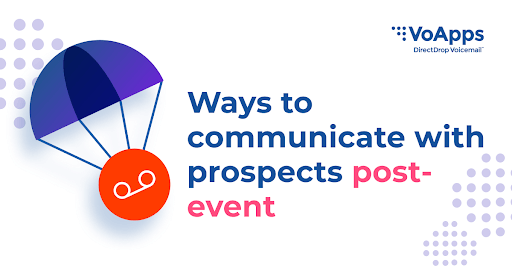Trade shows and events are a great way for your business to showcase your service or product and talk to people within your industry. Making connections, getting leads and gaining knowledge is key and trade shows allow you to do just that in a tailored environment.
That being said, as you’re looking to go to different trade shows this year, don’t forget to think about what happens after the show. You have an engaging booth, you make connections and you generate interest, but what happens after you leave? It’s time to start thinking about a communication strategy to connect with people after events so that you can stay top of mind.
Message contacts post-event
According to Rain Sales Training, “it takes an average of 8 touches to get an initial meeting with a new prospect.” That’s quite a few times to talk to someone and capture their interest, so you can’t leave it up to that one-off conversation at the event. Quick responses after an event are critical. You want to stay top of mind so they will think of you when the time is right. Here are a few things to consider when following up with your prospects post-event:
- Make your message short and sweet – touch on what you talked about when you met them at your booth
- Make your message more humanized and less sales-y
- Have a strong call-to-action
Once you have established your messaging strategy, it’s time to think of the channels of communication you will use to follow up with potential prospects.
Some of the best ways you can follow up with your prospects post-event:
- Follow-up emails
Email is one of the best ways to follow up with your consumers. Not only are you able to include all of the information you need to, but you can (and should) also include video or picture content. Including an image or video catches your prospect’s eye and is a great way to highlight an essential point (maybe use it to remind them of your booth at the event). With email, the prospect can open the message at their convenience, and either email back or call. It’s a win-win situation for both parties.
- Texting
Texting is often easier than a phone call. It’s an easy way to communicate short messages, and a fast way to increase those touchpoints. If you gathered numbers at the event or received them in an attendee list, try sending out a text message as a follow-up. Keep it short and sweet and thank them for their time at the event.
- Personalized Phone Calls
One of the benefits of calling people on the phone is getting an immediate response when they answer the phone. However, there is always the risk they won’t answer an unknown number. When they do answer the phone, though, there’s no delay in communication. You can also score some bonus points with them if you remember their name and details about their business. Recall specific conversations or meetings you had with them at the event.
- Voicemail dropping
Voicemail drops are another great option to utilize as you look to follow up with a prospect post-event. While many won’t answer a phone call from an unknown number, they will be likely to listen to a voicemail. This is a more personalized contact approach as the prospect can hear your voice and tone.
With our DirectDrop Voicemail platform, you can send voicemail drops to your prospects’ phones directly without ever manually dialing a number. DirectDrop Voicemail allows you to reach your audience without interrupting their day. It also allows you to scale quickly so you can reach many prospects at once. Reaching potential prospects without the inconvenience of manually dialing has never been easier.
We recently introduced a new “Transactional Campaign” feature which allows you to send a single message once a connection is made to follow up with these leads you meet during events, rather than having to create a file for each one or add a batch of phone numbers. This allows your business to strike while the iron is hot and fresh in a consumer’s mind. Read more about that feature here and why these work well as part of your contact strategy, too.

